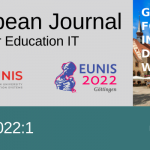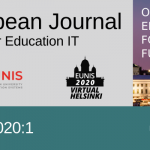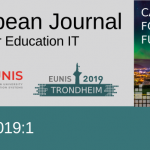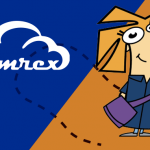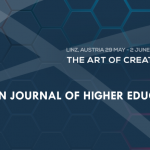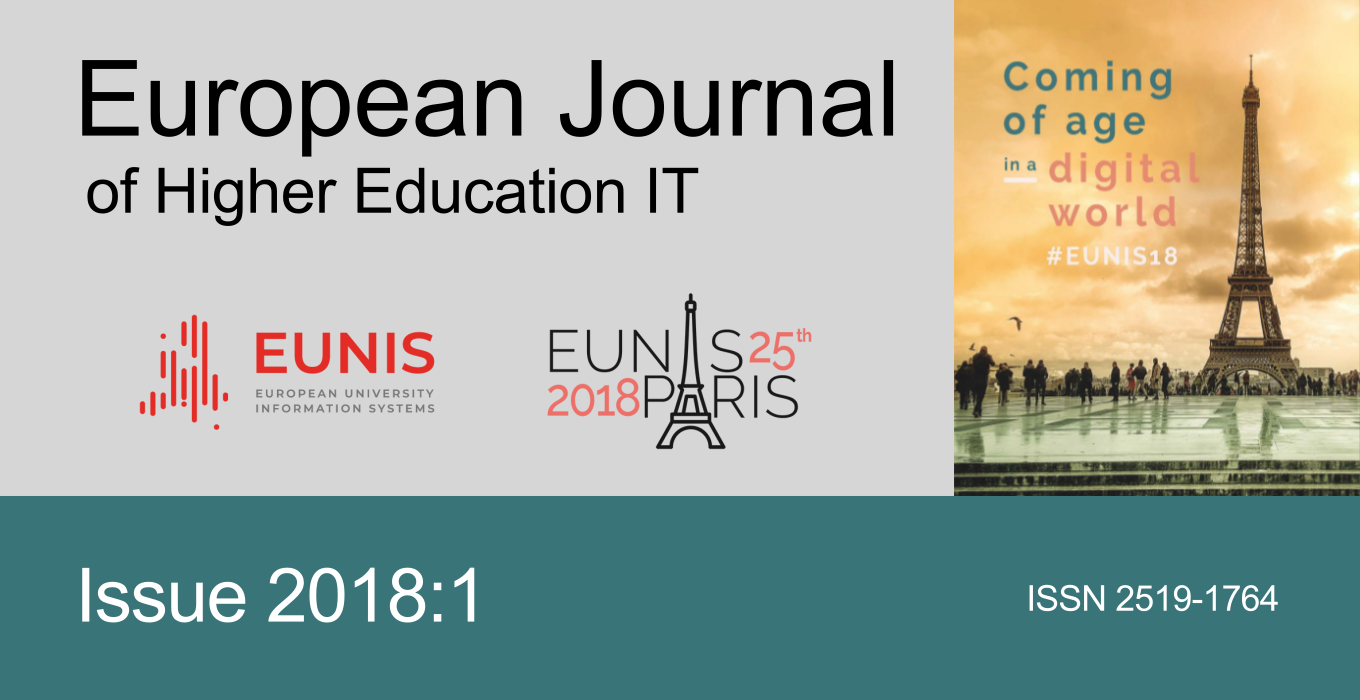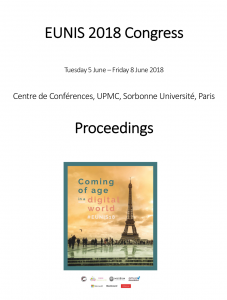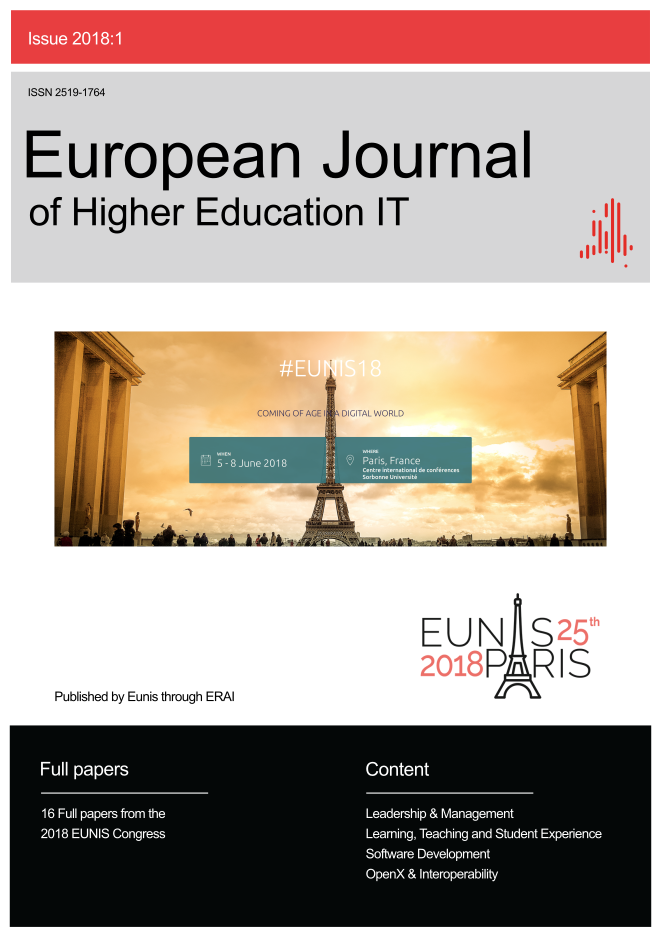
Reference to articles in this issue should be made as follows: name of author(s). title, European Journal of Higher Education IT 2018-1
European Journal of Higher Education IT – EJHEIT
This issue of the European Journal of Higher Education IT (2018/1) consists of the full papers from the EUNIS 2018 congress.
In total 18 scientific papers were submitted to the congress. In this issue there is a focus on the tracks Leadership & Management, Learning, Teaching & Student Experience, Software Development, and OpenX & Interoperability.
European Journal of Higher Education IT is a journal created to support the mission of EUNIS and to disseminate International Research within the field of higher education IT. Please also refer to the Editorial Committee.
ISSN 2519-1764
Leadership & Management
Factorial analyses in IT governance reveal constellations of decision shares and their consequences on IT in higher education institutions
Markus von der Heyde, Andreas Breiter
Abstract
The introduction of IT governance and the placement of CIOs at German institutions of higher education have been recommended for many years. In order to control digitization in higher education, a strategic concept to align business and IT as defined in IT governance is essential. However, who is involved in the decision-making processes very often depends on local conditions and the organizational culture and tradition. This aggravates the evaluation of the implemented models and the statistical comparison of their effectiveness. For the CIO study 2017 in Germany, representatives of 28 higher education institutions participated. They categorised their governance model and gave estimates of IT-relevant topics.
Our central research question focused on correlations between how decisions are made and how important these topics are regarded by decision makers. The results show that depending on who is involved in the process for decisions from the five classical domains, the estimates vary. To demonstrate this point, two principal component analyses (PCAs) and two factor analyses (FAs) were conducted. Finally, a model with typical constellations as alliances between the decision makers was derived.
Governance framework for digital transformation in higher education
Pekka Kähkipuro
Abstract
In most business sectors, the role of information technology is rapidly changing from a supporting function into a strategic asset, and higher education is no exception. Information technology can be used almost anywhere in an organisation and, consequently, a common approach for addressing digital transformation is to structure it as a collection of business capabilities across the board. This way, the organisation can adopt digital concepts without the bias of single digital programme or a narrowly managed digital slice of the business.
While business capabilities can provide structure and clarity to the implementation projects, there is an element that hasn’t been addressed sufficiently: IT governance and decision-making in the digital world. Complex sectors, such as higher education, cannot continue with traditional IT governance practices if they want to reach the full potential available through digital transformation.
In this paper, we propose a governance framework to address the underlying complexities of the digital world. The idea is to group digital capabilities into four clusters with sufficiently similar governance requirements. The technical cluster combines the IT infrastructure and similar new capabilities under a governance style that is close to existing IT practices. The mainstream digital cluster consists of capabilities that form the organisation’s official digital agenda, and the governance model is often driven by business growth and differentiation. The evolving digital cluster represents non-mainstream capabilities with the potential of moving into the core business, and the governance style is often similar to project or programme governance. Finally, the opportunistic cluster represents the first stage of the digital innovation pipeline and is a critical element for those organisations that are using digital transformation for their competitive advantage.
We present the governance framework through examples from the higher education sector. While the model has been designed with this sector in mind, it can also be used in other similar complex and multifaceted organisations independent of the underlying business.
Digitalization of Higher Education from an Academic’s Point of View
Anne Thoring, Dominik Rudolph, Raimund Vogl
Abstract
It appears to be just a matter of time until the digital transformation fundamentally changes university life – even in Germany, where the higher education (HE) sector seems to be widely unaffected by now. University IT centers will face challenges in all fields of activity. On the one hand, infrastructures and services have to be adapted to fulfill new demands expressed by different stakeholders, including researchers, lecturers, students, and administrative staff. On the other hand, stakeholders have to be informed about existing possibilities opened up by digital tools. Both aspects necessitate an examination of the stakeholders’ perpectives on digitalization in HE. Since IT services show great promise particularly for studying and teaching, two explorative studies, focusing on students and academics respectively, were conducted. In this paper, we report on the result of the second of these studies in which we interviewed lecturers to gather information on the status quo of digitalization in teaching and identify room for optimization at Münster University. The lecturers’ experiences and suggestions demonstrate that an improvement of the IT infrastructure and equipment is only secondary. Instead, a centralization of information, knowledge and expertise in the field of digital teaching is required. Lecturers wish for a “center for digitalization” which they can contact for information and practical advice on existing IT services, for counseling on digital teaching concepts, and for support in the implementation of new digitalization ideas. From the lecturers’ point of view, the university’s management has to overcome concerns that digital teaching inevitably results in an entirely virtual university. Rather, the university should go one step further and value lecturers’ efforts by creating incentive systems for excellent new forms of teaching.
Building Data Science Capabilities into University Data Warehouse to Predict Graduation
Joonas Pesonen, Anna Fomkin, Lauri Jokipii
Abstract
The discipline of data science emerged to combine statistical methods with computing. At Aalto University, Finland, we have taken first steps to bring educational data science as a part of daily operations of Management Information Services. This required changes in IT environment: we enhanced data warehouse infrastructure with a data science lab, where we can read predictive model training data from data warehouse database and use the created predictive models in database queries. We then conducted a data science pilot with an objective to predict students’ graduation probability and time-to-degree with student registry data. Further ethical and legal considerations are needed before using predictions in daily operations of the university.
Data-driven indicator classification and selection for dynamic dashboards: The case of Spanish Universities
Rafael Molina-Carmona, Faraón Llorens-Largo, Antonio Fernández-Martínez
Abstract
In the context of business, dashboards are visual tools that display the most important information about the organization needed to help the top management to make decisions. Since it is important to just provide the relevant and objective-oriented information, the number of indicators included in the dashboard must be kept at minimum. Therefore, the crucial aspect when designing dashboards is the selection of the suitable Key Performance Indicators. To help to carry out this task, we propose a classification and selection methodology, based on the values of the own indicators. This methodology is performed in two main steps: the classification of the indicators in three categories (emergent, hot and consolidated indicators) and the selection of the suitable set of KPIs based on the organization strategies. To illustrate the application of this methodology, we also present a practical case of indicator classification and selection for Spanish universities based on the extensive UNIVERSITIC report.
Information Technology Governance for Tunisian Universities (ITG4TU): a real experience of IT governance framework capacity building from European Universities
Beatriz Gómez, Carlos Juiz, Ricardo Colomo-Palacios, Antonio Fernández
Abstract
Information Technology (IT) are becoming an essential part of the business and boards are expecting value from it. However, the results are not always as expected so that they are realizing the necessity to govern IT. IT Governance (ITG) is a matter of each kind of business including universities but unfortunately, the adoption of best practices in order to conduct to good governance is still scarce. Regarding the three obstacles that obstruct the adoption of IT governance in universities namely ITG best practices absence, budget constraints and the inexistence of any method for implementing a framework, and mainly in developing countries like Tunisia, we have developed a project to provide them our expertise in implementing IT governance based on previous experiences but adapted to their specifically necessities and current situation.
Teaching & Student Experience
Learning Spaces around the world: an international comparative approach
Augeri John
Abstract
During the last decade, the innovative physical Learning Spaces, usually shortened to « Learning Spaces » have continuously increased as a hot topic, especially in the Higher Education world (Oblinger, 2006). These spaces consist to a mix of innovative spatial organization, layout, furnishing and ICT equipment, and seek to support – and sometimes induce – innovative teaching and learning practices, such as active learning, flipped classrooms, collaborative work and project based learning (Byers, T., Imms, W. & Hartnell-Young, E., 2014).
After a first rush mostly based on Active Learning Classrooms designed for formal teaching and learning activities, the Learning Spaces trends now tend to move to larger and integrated spaces such as Learning Commons and Learning Centers, more focused on informal practices, and that are often considered to represent the future of university libraries, as they usually are located inside them or replace them.
Considering the internationalization of this Learning Spaces phenomenon, and the relevance to compare experiences and share the best practices, an international comparative study has been formally launched in October 2016 by Paris Île-de-France Digital University (France) and Kyoto University (Japan).
This paper presents the study’s range, framework and methodology, as well as the first results and outcomes collected during its first year.
Risk Mitigation in the Age of Learning Analytics
Alan Berg, Gábor Kismihók, Patrick Lynch
Abstract
Despite rapid growth, the deployment of LA is still fragmented, and there is limited evidence of success available. This fragmentation decreases the visibility of results and experiences and amplifies possibilities for duplication in effort. Fragmentation and the bias of researchers to publish only successful studies increases the likelihood that we do not take into account lessons learned from failure and thus duplicate our efforts around mitigating actions. We should be highly motivated to decrease failure as it costs, the prime example being the Inbloom disaster, which impacted on many tens of thousands of students.
To structure this debate, we review the currently available frameworks that support the deployment of large-scale LA infrastructure and define a strategy of curation of a global risk mitigation matrix (risks vs mitigative actions). We show how a risk mitigation matrix can be attached to any deployment framework improving both the framework and the quality of the matrix. Finally, based on hackathons, to kick off curation, we suggest a series of interconnected workshops to facilitate the take-up this methodology to generate a periodic strategy document with associated top ten list of mitigations.
Honey I shrunk the data: data-informed blended learning design
Gill Ferrell, Samantha Ahern, Patrick Lynch, Nataša Perović, Clive Young
Abstract
Blended learning (a combination of face-to-face activities and use of digital tools and resources) is increasingly common in higher education. However, it is not always evident that people fully understand the benefits of including digital in the learning mix or, indeed, how to tell if the approaches they use are actually working.
In some cases institutions are setting ‘quotas’ for moving learning online without really thinking through what kind of learning is best supported in this manner. Conversely, there are some institutions that pride themselves on face-to-face learning and do not see how a blended approach can improve on this.
The authors of this paper are currently undertaking research intended to help academics, and those supporting the development of academic programmes, to improve how they design and evaluate blended learning. This paper outlines the approach and the supporting conference presentation will outline the results of pilot work and evaluation to date.
We are developing a technique to help ensure that blended learning designs are purposeful. We seek to make explicit the pedagogic intent in a learning design and then go on to explore how data can enable us to understand whether learner behaviour is corresponding to our expectations or not.
This is a proactive approach to learning analytics. Rather than sifting through a mass of data looking for patterns, we are designing in such a way that the data to tell us exactly what we need to know is readily available. We will show how the insertion of digital activities, with a clear pedagogic purpose, into the learning design has the power to support real-time interventions that can make a difference to learner outcomes.
We chose the title to make the point that, with a carefully crafted learning design, small data ‘hooks’ can be every bit as useful as Big Data.
Learning Scorecard Dashboards: visualizing student learning experience
Elsa Cardoso, Tiago Pedroso, Francisco Rações, Artur Baptista, José Barateiro
Abstract
This paper presents the design of dashboards for the Learning Scorecard, a platform designed for improving the student experience in a Higher Education course using gamification and Business Intelligence (BI) techniques. LS is a Learning Analytics application, that has been used in Data Warehouse and BI courses in a University setting since 2016. The LS platform has two independent views: student view and faculty (or course coordinator) view. In the LS faculty view, dashboards were designed according to the best practices of information visualization for decision support, whereas in the student view the visualization of the learning experience is immersed in gamification elements. This paper focuses only on student dashboards, which are driven by engagement and motivation of students to improve their collaboration and learning experience. A central design decision for the LS implementation, was the recognition that the way students want to track their progress and their learning experience in a course is fundamentally different that the way teachers need to monitor student progress. The presented learning dashboards use gamification mechanisms to enable the visualization of self-assessment results giving a clear indication of the learning progress of students in a course.
Integrating Moodle Learning Platforms with Academic Management Systems for Teachers
Jordi Cuní, Estefania Muñoz
Abstract
Teachers are using e-learning platforms in their day-to-day activities. These e-learning environments such as Moodle 1 and Sakai are not linked to the SiS 2 system, so when the teachers use them they have two different environments where the information is not connected. Actions like grading exams, class lists and so on have to be done at the e-learning platform and then updated to the SiS system.
After the enrolment process, the list of students with a group assigned has to be updated in the e-learning platform. Here, the difficulties appear when a SiS group in the e-learning environment is split into n-smaller groups where all of them stand alone in the e-learning platform but are attached to one single SiS group. The opposite could also happen with two or more SiS groups in a unique e-learning group. These changes can be done during the academic course and all the materials, grades,… have to be keep updated in both environments.
SIGMA has been working to eliminate this barrier providing a number of services in the Moodle virtual platform that enable academic management systems and virtual campuses to work together. The aim of the project is to add the necessary plugins to the e-learning platform automating the relations between groups in both sides and offering a set of SiS typical functionalities such as, class lists, partial grades, links to the academic files … .
SIGMA currently offers to the universities of the consortium two environments in SaaS, efficiently maximizing the information in the academic management system allowing teachers and students to make the most of it.
This integration ensures the automatic creation of Moodle courses from the groups defined in the syllabus and teacher’s assignments, so all the courses are available in Moodle after the university enrolment period.
We created a number of utilities in the teacher’s Moodle workspace that allow them to interact with the academic management application directly from Moodle without opening a new session in SIGMA SIS. The complete lists of integrations up to date are:
o Check the class lists
o Check student records
o Enter final grades in SIGMA SIS
o Transfer and calculation of grades
o Management of alphabetic gradeso Check grades template
o Manage records
o Transfer of records to SIGMA SIS
o Reviews of exam dates
o Closing records
o List of records
In addition, we have developed a component that allows the teacher to pass the final grades recorded in Moodle directly to SIGMA SIS, linking the daily assessment tool with the academic administration tool.
Only a change is constant – student digital experience in the academic on-line English language courses at the University of Warsaw
Anna Pacholak, Monika Galbarczyk
Abstract
The implementation of the innovative and modern didactics is an important goal in any university development strategies. One of the forms of reaching this objective is the inclusion of the ICT into the didactic process. The Centre for Open and Multimedia Education UW has been implementing it with the support of the extensive application of e-learning EFL methodology. As a part of this process the on-line foreign language courses have been introduced to the students’ curriculum, parallel to the stationary courses, which leads towards obtaining qualifications following flexible learning paths. Progressively, multi-level e-courses together with on-line placement tests have been created. They are currently used by over 5 500 users every academic year.
The paper covers a short description of the nature of the online English language courses as offered to students nowadays. Most of all, however, it focuses on the analysis of the outcomes of the end-of-semester student survey, reporting on their digital experience and the reception of the changes introduced in the chosen task formats in the online English language courses. It may possibly – suggest solutions for future online foreign language teaching educational contexts.
Comparative analysis of the use of video lectures and web 2.0 applications in a hybrid university course environment: a case study
Goran Bubaš, Antonela Čižmešija, Andreja Kovačić
Abstract
Use of online video and audio lecturing is an effective means to deliver asynchronous teaching resources to students in a hybrid academic learning environment. The lecture that was delivered by the teacher in the classroom can be recorded and placed on a video sharing network like YouTube and/or in a learning management system (LMS) to be available to students for later viewing and preparation for assessment. Also, the audio recording of a lecture can be easily created with the PowerPoint Slide Show recording functionality or by using screen capture or screen recording software like Camtasia and also placed in the course LMS to be used by students for learning. In most previous studies the students’ evaluation of such video or audio lecturing resources has indicated their potential contribution to learning, even though their adoption by the students was moderated by their learning styles and preferences.
A better insight into the value of video and audio lecturing can be provided by a comparative analysis of the use of video and audio lectures and other types of online learning technologies. Therefore, in our paper we compare the students’ perceptions of several aspects of video and audio lecturing and the value of their use for learning with their perceptions of the use of other technologies suitable for online teaching and learning: Diigo social bookmarking and notes-taking tool, Mendeley tool for organization of research documents, Google Documents, Google Slides, Google Forms, YotForm web survey tool, online mind mapping tools (Mindomo/Mindmeister/Bubbl.us), online block-diagram tools (Gliffy/Creately), Netvibes mashup tool, user interface mockup or wireframe tool (MockFlow/Mockingbird), and online presentations (Prezi/Emaze). The results of our comparative analysis of students’ evaluations of various types of tools that can be used for teaching and learning tasks indicate that video and audio recordings of lectures are among the highest ranked tools regarding the average evaluation of interestingness, usefulness, potential for knowledge acquisition, better understanding of course content and its long term retention.
The effect of implementing web 2.0 tools on the development of grammar competence in a hybrid English as a foreign language setting
Andreja Kovačić, Goran Bubaš
Abstract
Although the effects of the integration of web 2.0 tools for the development of writing skills in teaching English as a foreign language (EFL) have been documented in literature, an integrated use of wikis and other asynchronous web 2.0 tools for the improvement of grammar competence in a hybrid EFL setting remains fairly unexplored. This paper investigates the potential of implementing various web 2.0 tools for the development of students’ grammar skills in a tertiary English as a Foreign Language course. We present the results of an experimental study conducted among first-year undergraduate students engaged in collaborative form-focused activities in a hybrid EFL course. In these collaborative online activities the students’ written language production in a wiki was accompanied by multimedia artefacts representing particular EFL grammar concepts which the students created using web 2.0 tools. The described activities represent an innovative fusion of elements from EFL pedagogy, computer-assisted language learning (CALL) and multiliteracies education. Since the data analysis of grammar competence tests did not yield a significant statistical difference between the grammar competence level measured after the completion of the online grammar activities in the experimental and the control group, it can be concluded that the use of a wiki and other web 2.0 tools in performing online grammar activities in this particular hybrid course did not have a noticeably greater impact on grammar competence development in terms of the acquisition of the specific grammar structures selected for this study and in comparison to the use of a more traditional technology (e.g. MS Word) for the completion of an equivalent learning task.
OpenX & Interoperability
(Recipient of the Eunis Elite Award)
POL-on: The Information System of Science and Higher Education in Poland
Marek Michajłowicz, Marta Niemczyk, Jarosław Protasiewicz, Karolina Mroczkowska
Abstract
The aim of this paper is to introduce the Information System of Science and Higher Education in Poland, POL-on. It is an integrated and centralised information system which supports the Ministry of Science and Higher Education, as well as other ministries and institutions related to science and higher education. The system acquires data from universities and research institutions, analyses these data, and supports the decision-making processes of governmental bodies such as funding, evaluating, controlling, monitoring, and informing. The POL-on system has been continuously developed since 2011. Nowadays, it is a mature and fully deployed system. However, there are still ongoing modifications and improvements that result from the user needs or the law changes. Moreover, POL-on is going to be the essential part of a new integrated system of services for science, which should increase interoperability of the whole information ecosystem with domestic or European institutions or entrepreneurs. As a result, it should increase innovativeness.
Software Development
How to Foster Open Access? An Empirical Evaluation of the Obstacles hindering OA-Publication
Dominik Rudolph, Anne Thoring, Raimund Vogl
Abstract
While open access (OA) publications are fostered by politics and funders as a way to reach large audiences and widely spread the results of research, the share of OA publications remains low. To foster OA, it is crucial to know the reasons hindering the diffusion of OA publication strategies. Therefore, we conducted a quantitative survey among researchers at the University of Münster, one of the largest universities in Germany. We tested different hypotheses focusing on several obstacles, including a low impact of OA, a low reputation of OA, and high costs of OA. Our findings show that the OA publishing rate at Münster University is low, despite the fact that OA publications are heavily used as scientific sources, OA publishing strategies receive a high rating and the reputation of OA is very positive. The willingness to pay, however, is significantly lower than the actual costs of OA publications. In addition, we identified a lack of information and a high uncertainty as supplementary reasons for a low OA rate. As expected, we found large differences between the departments. While OA publishing seems to be common in the life sciences, the natural sciences and mathematics, its usage is significantly lower in the humanities and social science, and especially in economics and law. It turns out that a researcher’s low number of OA publications is positively correlated with 1) an assumedly low reputation of OA in his field of research, 2) a limited usage of OA papers as a source, and 3) a negative attitude towards OA strategies. Even though the willingness to pay is not significantly correlated with the OA publication rate, costs seem to be an important factor because the actual costs overrun the willingness to pay by far.

